The Staffordshire Bull Terrier growth chart is a tool that can be of great help to all breeders and owners of these powerful canines.
Growth charts can help you predict the size of your pup when it grows up, and they also help you monitor their weight and prevent obesity or malnutrition.
In case you’re planning to own a Staffy or you already have one, I’m sure this growth chart will be of great help.
Staffordshire Bull Terrier Growth Chart
| Age | Weight |
|---|---|
| 12 weeks | 11 – 15 lbs |
| 16 weeks | 13 – 20 lbs |
| 20 weeks | 17 – 25 lbs |
| 24 weeks | 18 – 28 lbs |
| 28 weeks | 20 – 30 lbs |
| 32 weeks | 21 – 33 lbs |
| 36 weeks | 22 – 34 lbs |
| 40 weeks | 23 – 35 lbs |
| 44 weeks | 24 – 36 lbs |
| 48-50 weeks | 24 – 37 lbs |
Staffordshire Bull Terrier Puppy Growth Chart
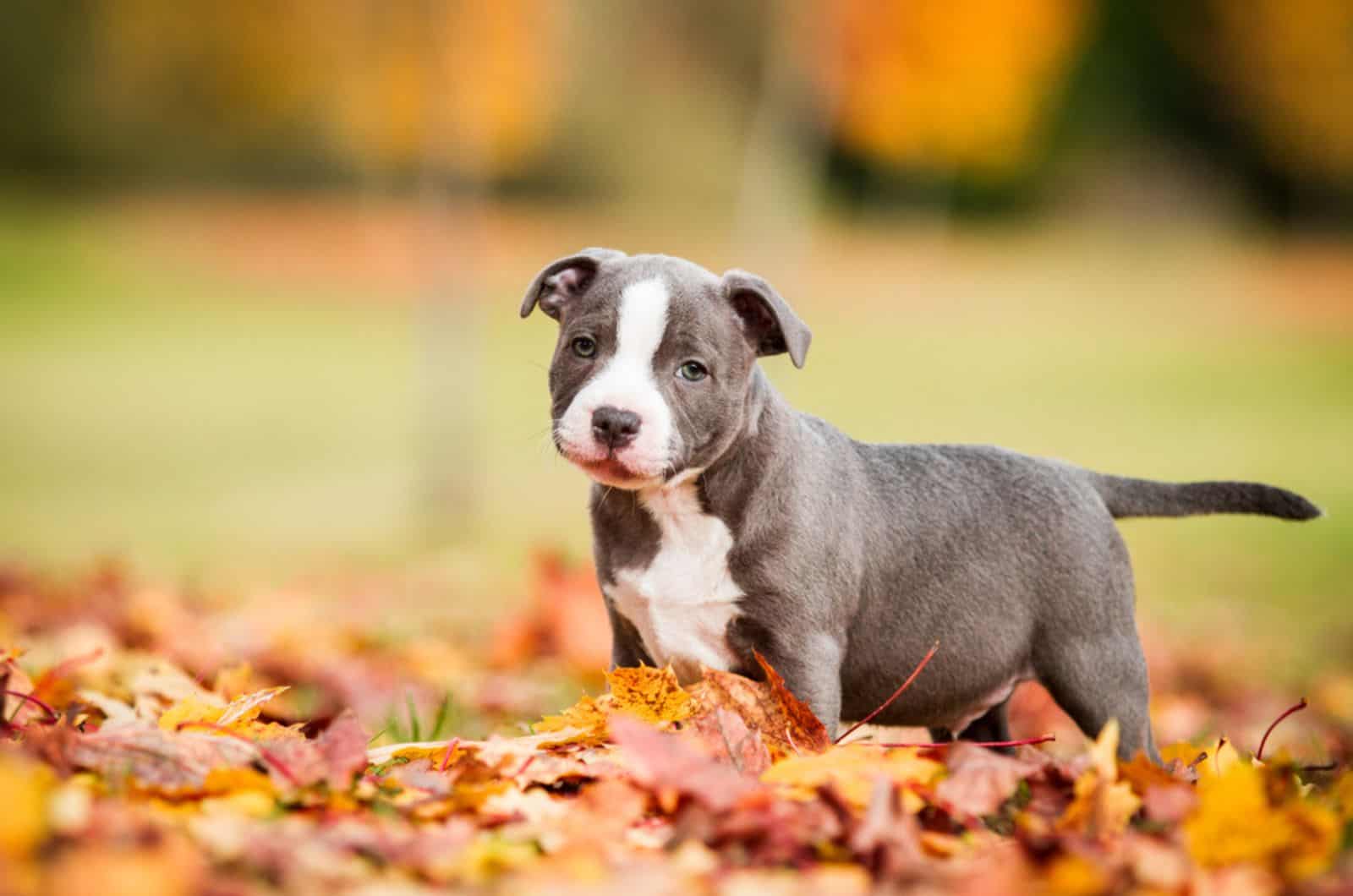
The Staffordshire Bull Terrier growth chart is a tool that will help you easily monitor the development of your pup throughout different stages of its life.
Not every dog will develop in the same manner, so even if your pup has a few pounds more or less than what is stated in the weight chart above, that won’t be such a big deal.
However, if there’s a great difference between your dog’s weight and the estimated weight for its age, you should react immediately by changing its diet or contacting a vet.
In the next few paragraphs, we will discuss the growth process of Staffordshire Bull Terrier puppies in detail, from the day they’re born until they become fully mature canines.
First Two Weeks
The first three weeks are considered the neonatal period for any type of dog breed, including Staffies. During this stage of life, puppies are completely dependent on their mother, which is their main source of food and security.
Mother’s milk is one of the essential food sources for newborn puppies as it contains the nutrients that will help Staffy puppies develop in a healthy way.
The mother’s closeness and warmth increase the chances of survival of each puppy, especially since the pups at an early age aren’t able to control their own body temperature.
At this point of life, all your Staffy will do is sleep and eat (you might get a few minutes for cuddling). They usually don’t walk much until they’re at least three or four weeks old.
The main reason for this is the fact that the muscles of their legs aren’t properly developed yet. Some pups might start walking a few days before the third week, but that mostly depends on their overall development process.
Therefore, if you notice that your Stafford puppy sleeps for a long time, don’t worry – there’s nothing wrong with it; they simply don’t have better things to do at the moment.
There is one thing you should keep in mind during this stage – deworming. It is strongly recommended to deworm a dog during the first two weeks of its life since it is more prone to parasites during the neonatal stage.
Two To Four Months

The second month of the puppy’s life is considered as a transitional period of its development as it opens its eyes for the first time during this stage.
It is believed that puppies don’t have good hearing during the first month, which is why they start reacting to the surrounding noises and voices after the neonatal period.
During this stage, they get to know the world around them, and make their first interactions with their siblings and humans.
This period is also marked by the appearance of baby teeth, which is a clear sign they can start eating puppy food and wean off their mother’s milk.
Essentially, the weaning process should begin during the third or fourth week of their life. If you notice that the Staffy mother struggles with weaning, you can help her by separating her from the puppies for an hour or two several times a day until the puppies stop nursing.
Every owner and breeder of Staffordshire Bull Terriers is supposed to take the puppies for their first round of vaccines as soon as they turn two months of age, and before they go to their new home (if you’re planning to sell/give them).
Healthy puppies should develop all their senses by the third month of life (a few days, more or less). In case you notice that your pup is still not reacting to certain visuals, sounds, or smells, you should consult a health professional.
Four To Six Months
As soon as the Staffy pup turns four months old, you can expect a lot of changes to happen. First of all, your pup will go through certain physical changes, but it will also develop behavior patterns that will display throughout its whole life.
That’s exactly why it’s of critical importance to start with early socialization and obedience training.
A great number of Staffordshire Bull Terrier puppies become a bit rebellious during this period, which is also known as the “teenage months”.
Staffies can be a bit strong-willed from time to time, and if you don’t train them from early puppyhood, they will start showing signs of dominance, and will try to take control, even over their owner.
Therefore, it is important for you, as an owner, to become dominant and show your pup who’s in charge by training it. If you’re not sure how to successfully complete this task, you can consult a professional dog trainer for advice.
Another thing you’ll notice by the time they turn five months of age is increased shedding, which is the result of the transition from a puppy to an adult coat.
READ NEXT: Goldendoodle Puppy Coat Transition And Grooming Guide
By the time they turn six months old, a Staffy puppy’s weight should be at least half of its adult weight.
Seven To Ten Months
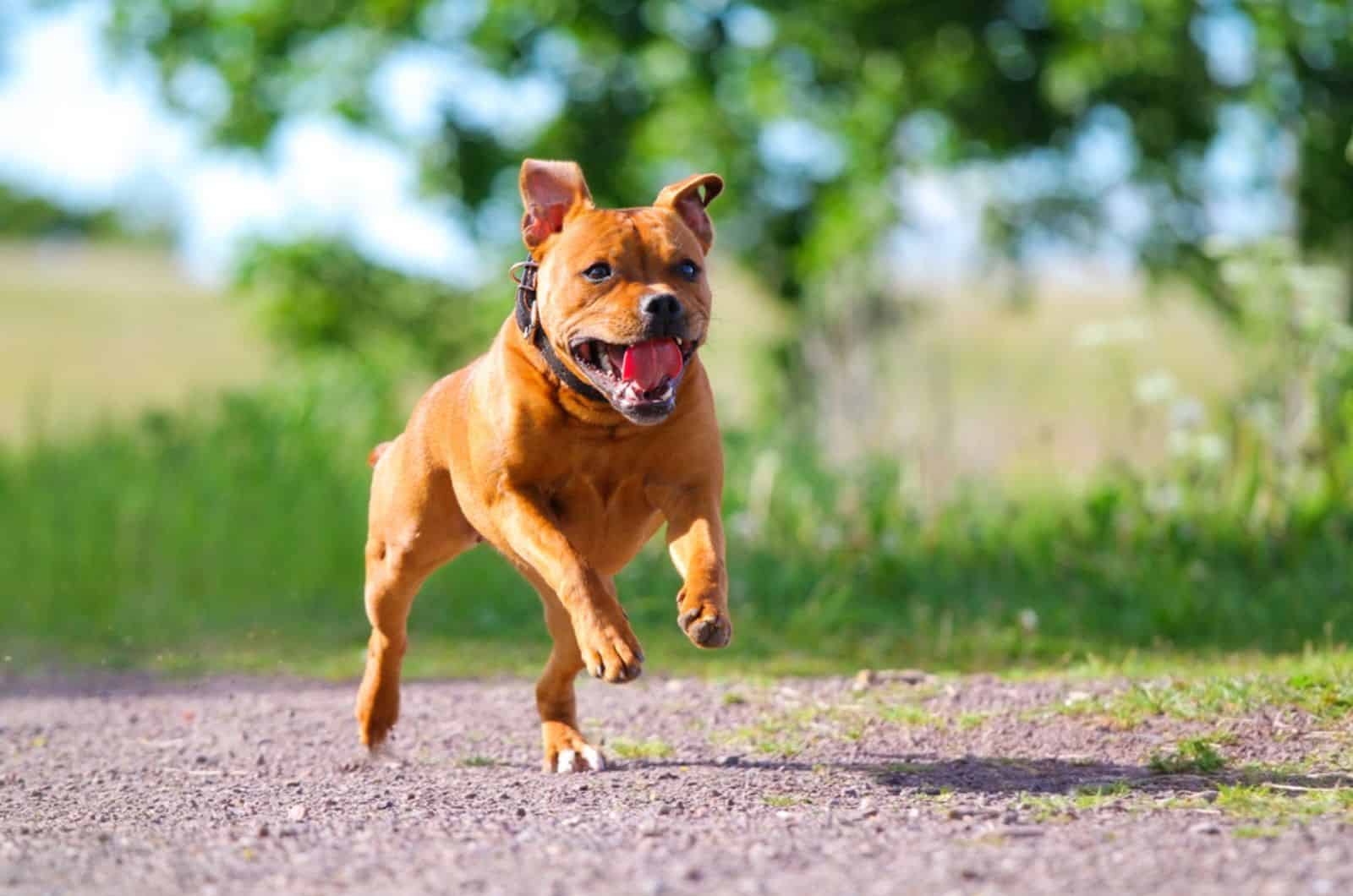
Puppies at this age won’t gain as much weight as they did during the first six months mostly because they become more active and spend most of their excess energy during playtime and training.
Since Staffies aren’t large dogs, you don’t have to expect them to grow as big as Great Danes, Cane Corsos, or Boxers.
Of course, pups will still progress in terms of size and temperament, but just not at the same pace as they did during the first months of their life.
A Staffordshire Bull Terrier should have all of its adult teeth by now. If that’s not the case, you should take your pet to a reputable health professional to remove the baby teeth (if there are any left).
It is recommended to spay/neuter the pups around the fifth or sixth month of its life, but if you haven’t done so, make sure to complete this task before they turn into young adults.
Training should become a regular habit at this point in the dog’s life. However, you should not forget about their grooming needs as well.
Trimming, brushing, and nail-cutting should also become a part of a weekly/monthly habit. Although Staffordshire Bull Terriers are low-maintenance dogs, they still require basic grooming.
RELATED: We Present You 33 Low-Maintenance Dogs For First Time Owners
Ten To Twelve Months
I’m not a pup, but not yet a mature dog.
Britney’s song has been in my mind as soon as I started writing about this period of a Staffy’s life, and for a good reason.
During this period, Staffordshires aren’t considered puppies anymore, but they still might not be fully developed as mature dogs.
However, it won’t take long until your pup finally looks like a strong, powerful, Pitbull-like canine.
A balanced diet will be the key to keeping your dog healthy and well-looking during this period, so make sure that you offer them the right amount of food at mealtime.
Be prepared for puppy eyes as soon as the bowl becomes empty, and be strong enough not to give them more in order to prevent obesity and all health issues that might come with it.
Twelve To Eighteen Months
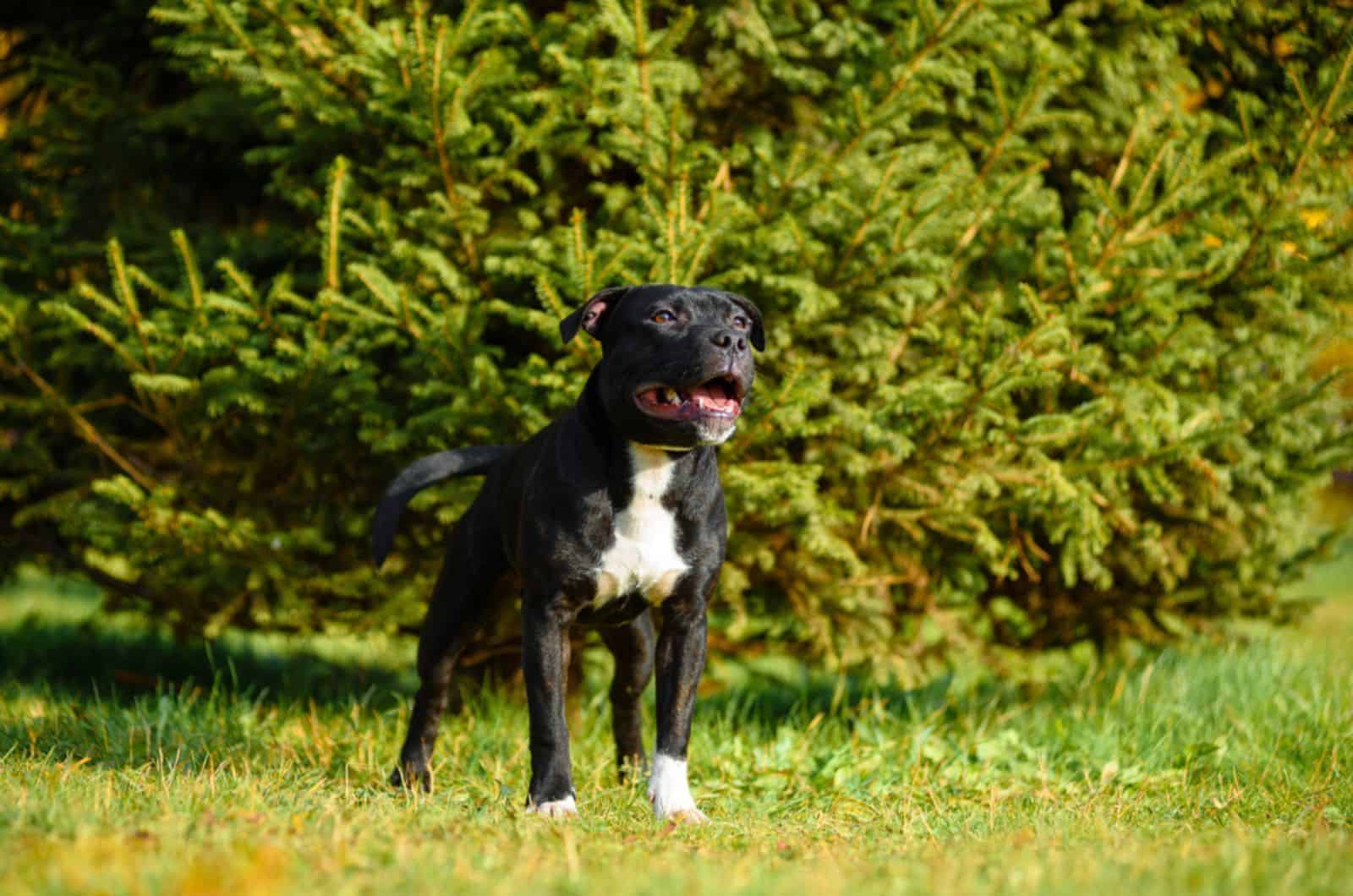
Congratulations… now you have an adult Staffy, at least according to the Staffordshire Bull Terrier growth chart.
The majority of Staffies are already fully-grown by the time they turn 13 months of age. It is highly unlikely that they will grow past this point, but there might be certain cases where pups are still not completely developed.
This is the right time to switch from puppy to adult food since the nutrition requirements change as Staffy pups get older.
If you continue using puppy food for a few weeks more, nothing bad will happen, but if you don’t make the transition after the pup turns 13 months, there could be serious consequences.
Deficiency in certain vitamins and minerals could lead to lethargy, skin issues, infections, and hair loss.
Also, puppy food contains lots of fats and carbs, which is completely unnecessary in an adult dog’s diet, and might only cause diabetes, obesity, or other health issues.
If you want to maintain the right weight of your Staffordshire Bull Terrier, you should offer them a balanced diet filled with the right nutrients for their age.
However, don’t make a sudden switch from puppy to adult food as this might cause stomach issues.
Adulthood
By this time, all Staffordshires should have become fully-matured canines with a well-developed body frame, including joints, bones, and muscles.
All canines that are over 18 months of age should reach adult weight. After that, they can gain or lose a few pounds, but generally, this weight should be maintained throughout the rest of their life.
To keep your pet from putting on extra weight unnecessarily, which will cause nothing else but health problems, it is essential that you feed them high-quality food in the right amounts for their age.
Also, make sure that you provide your pup with enough exercise during the day. Even though long walks are recommended, this shouldn’t be the only type of physical activity.
You can take your doggie to a dog park, which will enable them to spend energy and interact with other canines.
Make visits to the vet a part of their regular routine. This way, you will be sure that your pet is healthy, and you’ll also be able to detect any type of health problem at an early stage and treat it in time.
How Big Do Staffordshire Bull Terriers Get?

The Staffordshire Bull Terrier growth chart shows a rough estimate of the Staffy’s weight throughout the first year of its life.
If they’re fed adequately, there won’t be so many drastic changes in the dog’s weight after it turns one year of age.
But, the question still arises – how big do adult Staffordshire Bull Terriers actually get?
According to the Staffordshire Bull Terrier size charts, adult male Staffordshire Bull Terriers often weigh between 25 and 38 pounds, and they stand between 14 and 16 inches tall.
How Big Do Female Staffordshire Bull Terriers Get?
It is a well-known fact that female canines of almost every breed are smaller than their male counterparts, and the same goes for Staffy canines.
In terms of height, female Staffy puppies follow almost the same pattern of growth as male Staffys. However, when it comes to their weight, female dogs are usually a few pounds less than male ones.
An adult female Staffordshire Bull Terrier typically weighs between 24 and 34 pounds, and grows up to 16 inches, although their usual size is 14 or 15 inches at most.
How Do You Predict Their Size?
The confusion around the size of Staffy pups is usually caused by the mix-up of Staffordshire Bull Terriers with American Staffordshire Terriers.
Many people confuse these two breeds, which is why they’re surprised by the size of American Staffordshires, thinking that they’re actually Staffies.
That is one of the main reasons why it’s difficult for some people to predict the size of these dog breeds.
Instead of using general predictions based on other representative breeds, you can make certain estimates by examining your own pet.
There are several methods that can help you determine the adult size of your Staffordshire puppy.
The first one is to examine the size of its parents. If you bought a puppy from a reputable breeder, you can consult them on the size of their adult canines – the parents of your puppy, to be exact.
In general, female Staffies take on the appearance of their mother, while male Staffies take on the appearance of their father.
Other ways are either to check the size of the canine’s paws or perform a DNA test.
The size of your puppy’s paws is another predictor of the canine’s size when they reach adulthood. If the paws are significantly larger than average, it indicates that your puppy is still not fully mature.
However, if you’re sure that you have a purebred Staffordshire Bull Terrier, you can rely on the growth chart that follows their development from puppyhood to adulthood.
How To Measure A Staffordshire Bull Terrier?
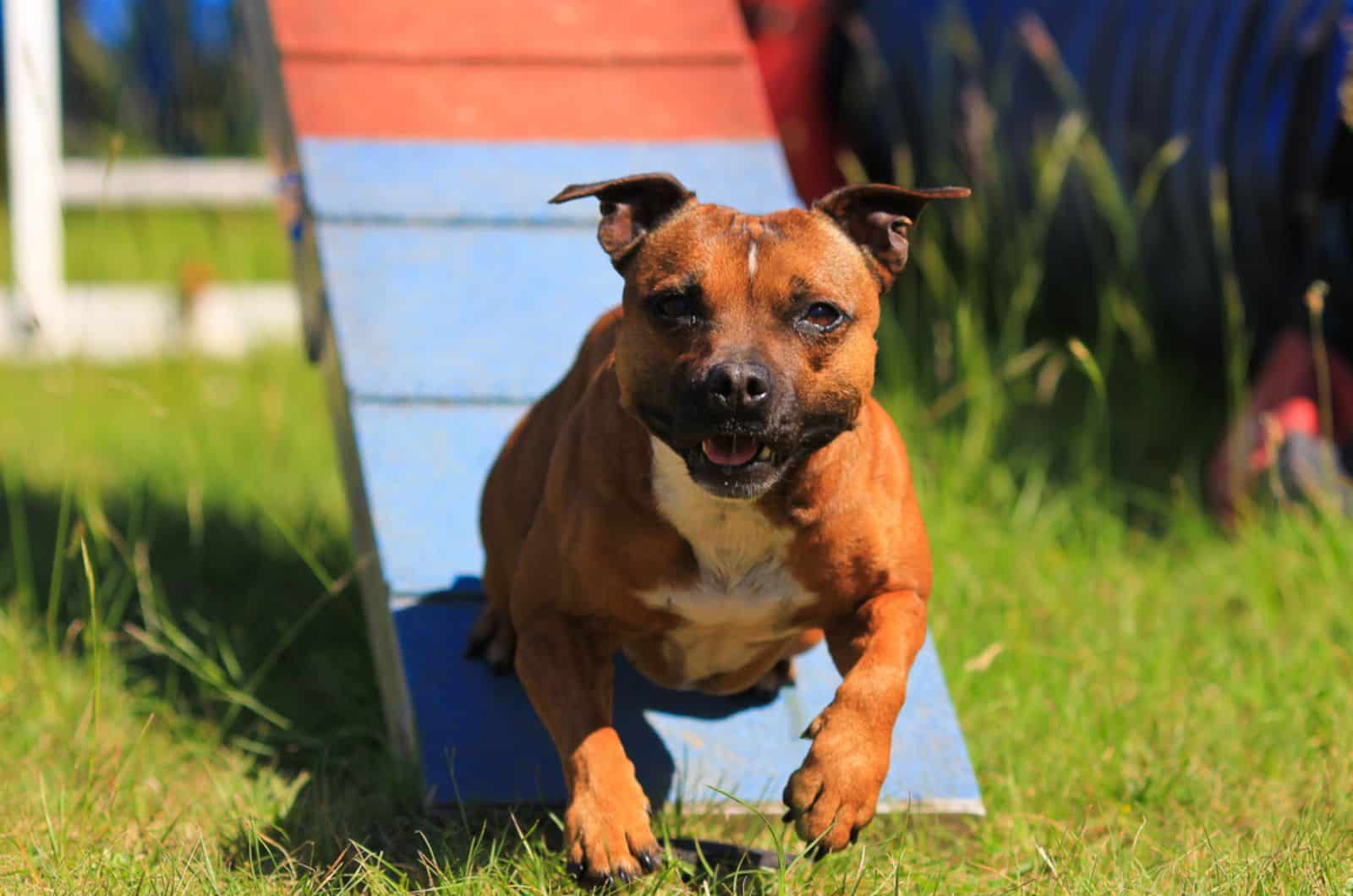
Knowing the precise measurements of your pup at any point in its life is truly unnecessary, but that doesn’t mean you should never measure it.
It is recommended to make periodical measurements of the canine in order to track its development. Also, if you know the exact measurements of your pet, it will be easier to get any type of dog equipment (harnesses or collars) in the proper size.
You can measure the height of your Staffordshire by standing it against a wall. Find the withers of the dog, and mark it on the wall. If you don’t want to leave marks, you can put your finger or use a sticker.
After that, all you need to do is measure the space between the floor and the marking point. The best way to do this is by using a tape measure.
When it comes to weight measures, you can simply take a bathroom scale, stand on the scale alone to measure yourself, repeat the action while holding your pup, and then subtract your weight.
This will be the weight of your pup.
Can Spaying Or Neutering Affect The Growth Of Staffordshire Bull Terriers?
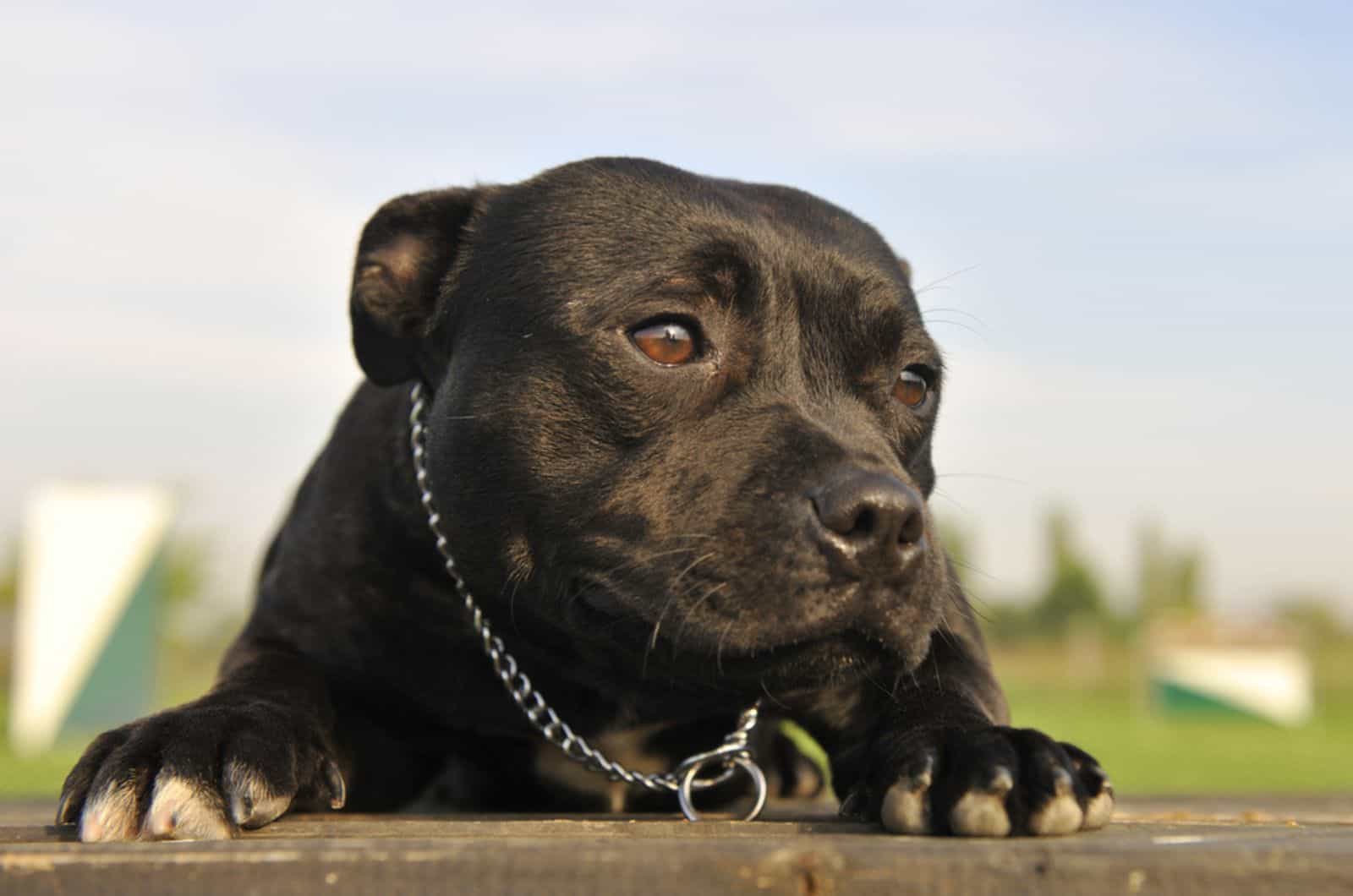
Although this might come as a surprise to some dog owners, especially those who don’t have prior experience, sterilization can affect the growth of canines in a great manner.
That is exactly why reputable breeders don’t spay/neuter puppies before they send them to their new home (most of the puppies are sold/given away at two months of age).
Hormones are an important factor for the healthy development of Staffies.
Early sterilization might prolong the time of bone growth in dogs, including Staffordshires, which causes them to grow taller than they’re supposed to.
Consequently, this can affect the development of joints, and cause orthopedic problems.
The best time for neutering/spaying is after the doggie reaches the heat cycle stage, which is generally between the ages of four and nine months.
If you’re not planning to breed any Staffies, it is generally recommended to spay/neuter them. Sterilization has quite a lot of benefits for both male and female Staffordshire Bull Terriers.
Spaying a female canine reduces the risks of ovarian and breast cancers, and also urinary tract infections.
When it comes to male dogs, it protects them from testicular cancer, and makes them less hostile.
What Affects The Growth Of Staffordshire Bull Terriers?

There are certain factors that might have an impact on the growth of Staffies, especially concerning their weight.
Diet is one of the first things that comes to everyone’s mind, which is true, but it’s definitely not the only factor that can affect a canine’s development.
Here are some of the most common reasons why your pup develops in a certain way:
Diet
It is essential to provide your pet with food, but it is even more essential to understand what the best dog food is for your beloved canine.
If you’re not into cooking meals or preparing raw food for your pet all the time, that’s okay. There are plenty of great brands and types of dog food on the market for you to choose from.
However, make sure that your pup is eating food that is appropriate for its age, and that it doesn’t contain any harmful substances, including artificial dyes, vegetable oils, nitrates, melamine, sugar, etc.
Instead, choose foods that contain proteins, fatty acids, fiber, vitamins, healthy fats, etc.
Make sure that the primary source of protein in the meal that you purchase is organic meat. Plant-based proteins are a good addition, but they might not be sufficient for energetic pups like Staffies.
Genetic Background
The majority of puppies inherit certain traits from their parents regarding both temperament and physical appearance.
That is why genes might significantly influence the growth of puppies as they usually grow to almost the same size as their parents.
Unfortunately, hereditary health issues might cause changes in a Staffy’s growth as well, although not every pup inherits the health conditions that its ancestors might have had.
Asking the breeder about the health records of the puppy, as well as questions about the dog’s parents, is important.
By studying their DNA, you can gain insight into the kinds of illnesses to which the dog is predisposed, as well as its physical characteristics in general.
Health And Physical Activity
The current health of your pup is crucial for its physical development, as well as any potential health issue that might appear in the future.
If the dog doesn’t get enough exercise, its muscles can seriously deteriorate, and it can also become more prone to obesity, which affects the health of the Staffy’s joints and bones.
As a consequence, these pups might not develop in the same manner as their healthy relatives, which is why they might either have a smaller body frame or become overweight.
Dogs that get enough exercise have a better chance of keeping their general health in good shape. They are able to maintain their physical fitness and a healthy weight when they exercise consistently.
How Do You Feed Staffordshire Bull Terriers?
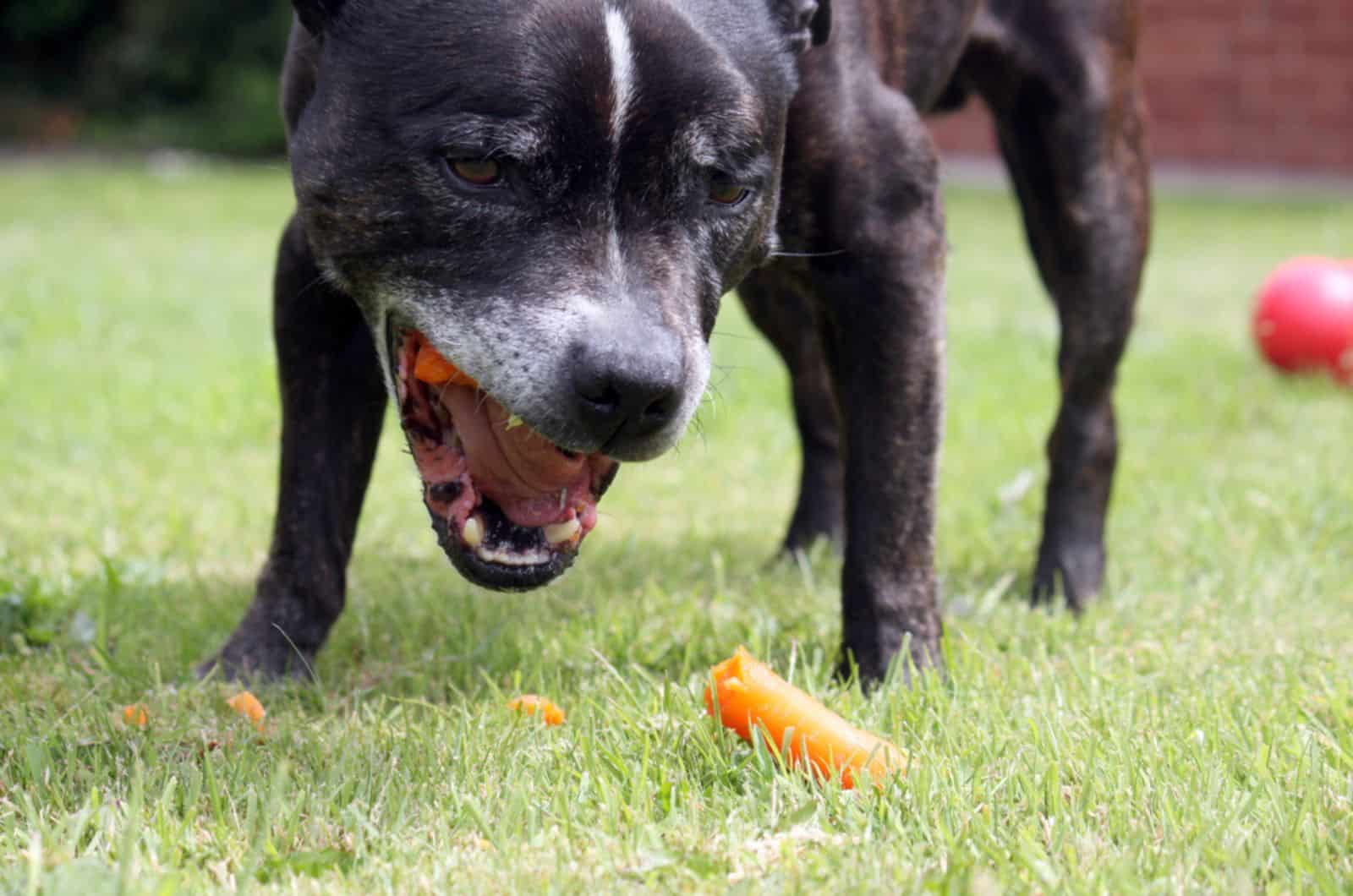
The amount of food that your dog receives will change throughout the different stages of its life. Since Staffy puppies spend more energy than adult dogs, it’s natural that they’re fed more often than mature Staffordshires.
It is generally recommended to feed Staffordshire pups two and a half cups of dog food over three to four meals per day.
However, these numbers depend on each pup individually as they don’t all develop at the same pace. Some doggies might require more food, especially those that are physically active and have lots of outdoor exercises, while others might require less (especially seniors dogs).
Puppies develop quickly, so it’s no surprise that they eat more than their parents. Still, this doesn’t mean they should be fed ten times a day.
It is true that Staffy puppies digest food faster and easier than mature canines, but it’s also a known fact that puppies gain weight more easily than mature canines, so think twice before you give in and feed your Staffordshire puppy a few kibbles more.
Due to the fact that each puppy’s metabolism and amount of energy are unique, it is important to ensure that their meals are appropriately portioned.
If you’re not sure how much food your dog needs, you can consult a vet or a dog nutritionist.
How Do You Tell If The Pup Is Underweight Or Overweight?
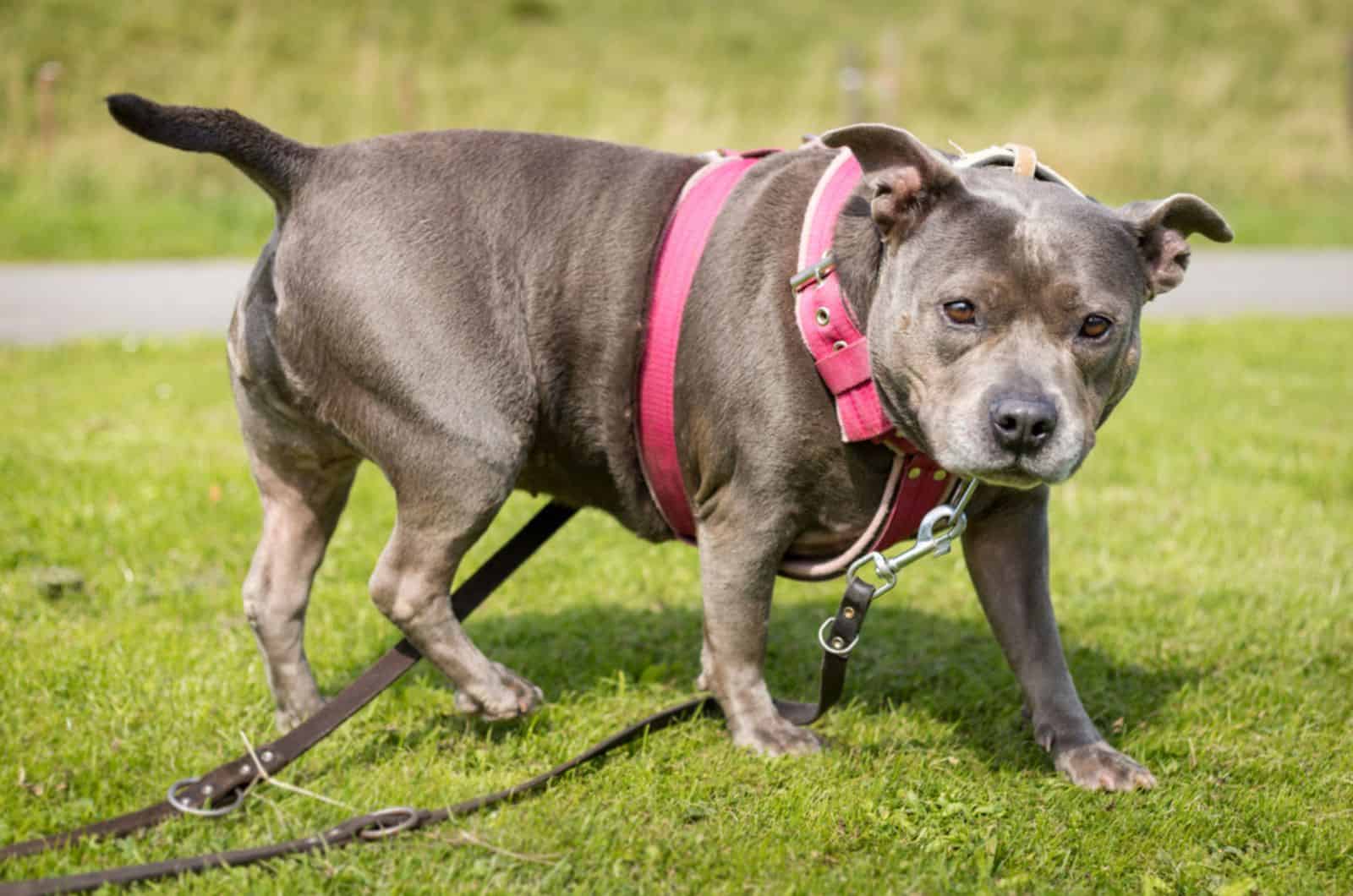
Obesity is a nightmare for almost all dog owners, even those who take really great care of their pups. It can happen to every canine, including those that are monitored constantly by their owner.
Many people will agree that it is almost impossible to say no to the heartbreaking look of their puppies when they ask for more food.
However, it’s even more difficult to fight obesity and all other health issues that come with it.
Unfortunately, some conditions are irreversible. This is why it’s important to monitor the development of your canine, and notice the first signs of your pup either becoming under or overweight.
The best way to check if your Staffordshire Bull Terrier is overweight is by looking at its chest and ribcage.
This type of canine is characterized by a strong chest that is significantly broader than its waist. If you can’t notice the difference between the width of its chest and stomach area, it’s a clear sign that your pup is overweight.
Another way that can show you whether your dog is overweight or underweight is by going over the dog’s ribcage with your hand.
If you feel a thin layer between the canine’s ribcage and its skin, it’s crystal clear that your pup is in perfect shape. However, if you can’t feel the ribs because of the thick layer of fat under the skin, then this means your pet is overweight.
On the other hand, if you feel the rib bones immediately after touching the rib cage area, and if this area is clearly seen under the skin, this means your doggie is underweight.
How Do You Help Your Pup If It’s Overweight?
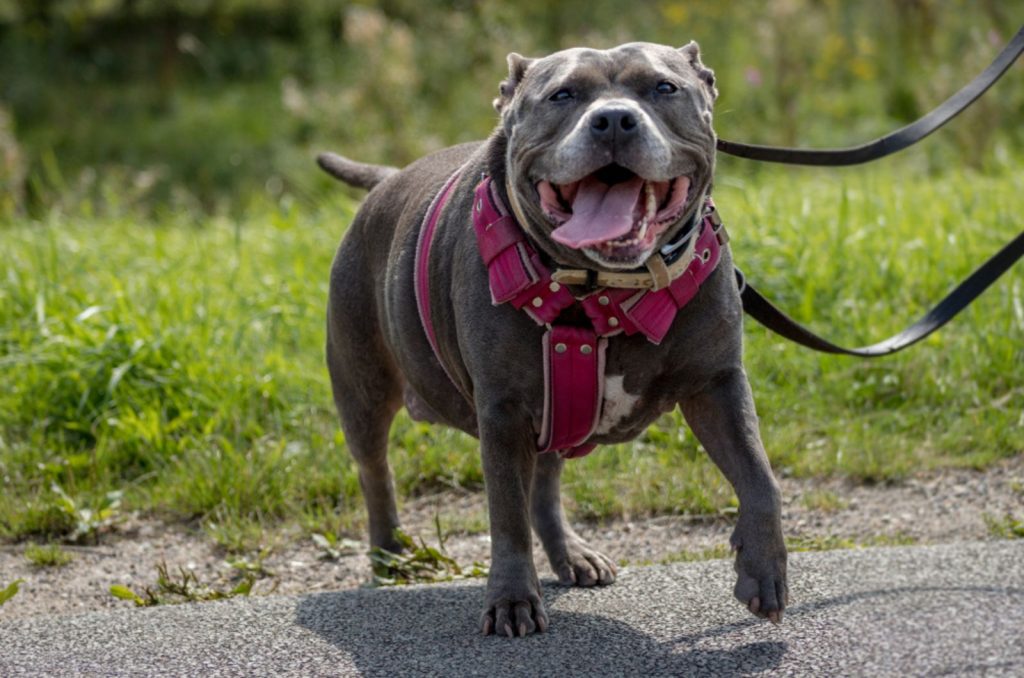
A balanced diet, physical activity, and an active family lifestyle are three essential aspects of keeping your dog healthy and in good shape.
If you start practicing all three of these in your household, your overweight pet will soon become a lot healthier and slimmer.
Staffies that are overweight might drop some pounds more quickly by combining healthy meals with regular exercise.
The best way to help your pet lose weight is to remove foods from its diet that contribute to weight gain, and be sure to provide it with sufficient amounts of food (underfeeding can be an issue just as much as overfeeding, so make sure that you find a balance).
However, before you try any of these weight-loss methods, you should take your pup for a checkup just to make sure that its weight gain isn’t caused by any unknown health condition.
You can give your pup nutritious snacks such as cooked carrot slices, green beans, and lean meat that have been prepared in advance.
The majority of human snacks should be avoided because of their high-calorie content, which can lead to a great increase in weight.
Exercise should be at the top of the obligation list regarding your pet. Walking in dog parks should be a part of regular habits. This way, your canine will be able to exercise while playing and socializing with other canines.
What Are The Most Common Health Issues Of Staffordshire Bull Terriers?
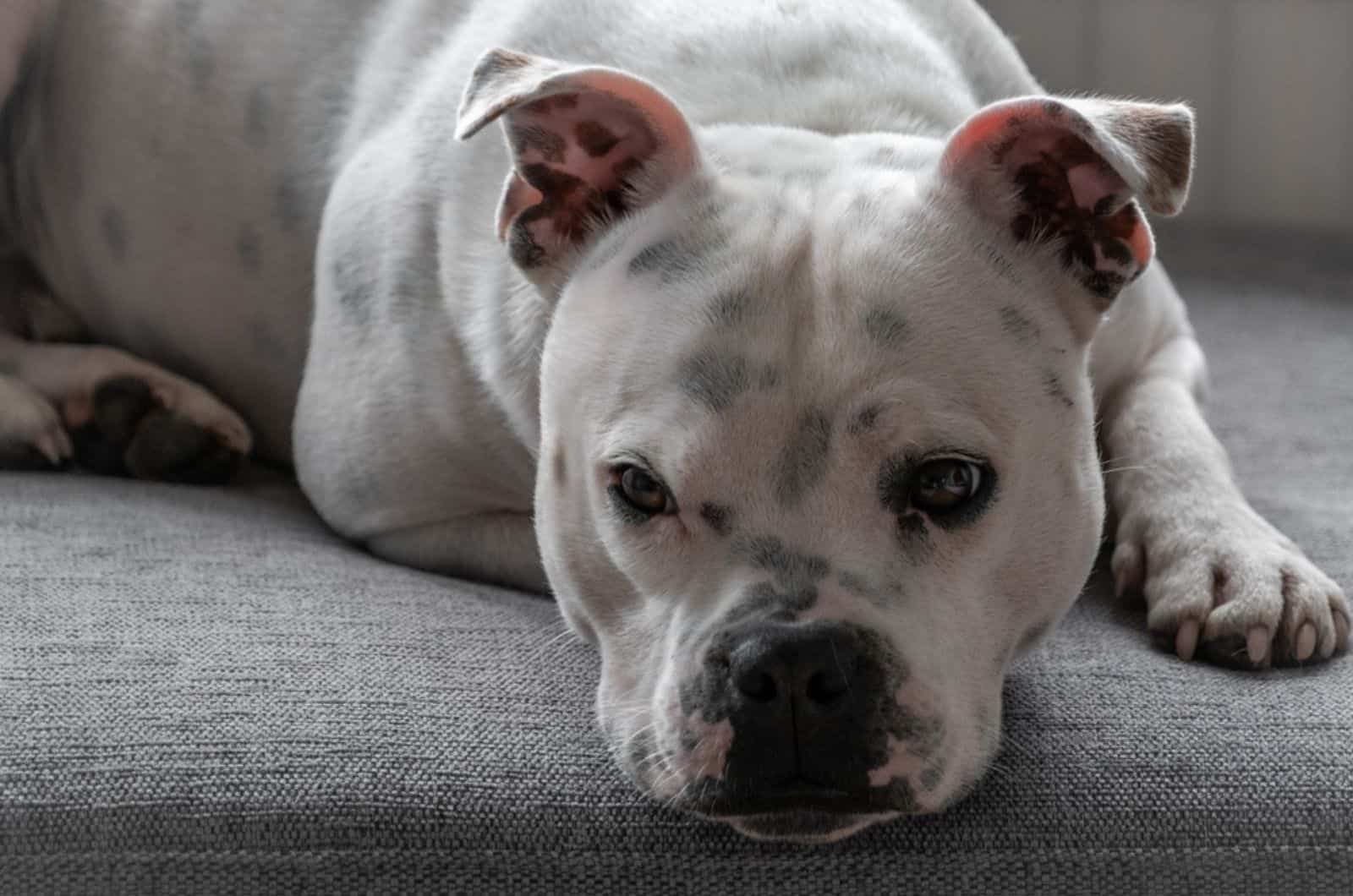
The Staffordshire Bull Terrier is a canine with strong stature that is powerful, muscular, and (generally speaking) in excellent condition.
However, although they’re considered a healthy breed, these dogs are also susceptible to a certain number of health conditions.
These health issues might not be directly related to the size of Staffies, but they could have a certain impact on their overall development.
The following is a list of the most prevalent health issues associated with this breed:
L-2 Hydroxyglutaric Aciduria (L-2HGA)
This almost unpronounceable health condition is considered as a neurometabolic defect that affects canines in a way that it causes signs of neurological dysfunction.
This type of condition is hereditary, but it has to be present in the DNA of both parents in order to be transmitted to the puppy.
Convulsions, tremors, and stiffening of the muscles during exercise are all symptoms of this neurological and metabolic defect.
You can expect your Staffy to show the first signs of this condition when it turns six months of age, but they can appear up to the first year of their life.
In order to prevent this condition from appearing in Staffordshire pups, it’s essential to subject all parent breeds to DNA testing before they breed.
Once you’re sure that all adult Staffies are healthy, and don’t contain any genes that could negatively reflect on their young, they are ready to breed.
Cataracts
This is a health problem that can affect both young and senior dogs, and it is mostly caused by genetic background, trauma, eye inflammation, metabolic issues like diabetes, etc.
If it’s an inherited condition, cataracts usually become apparent when the pup turns two months of age.
Regular checkups will help with the early diagnosis and treatment, which is mandatory in order to prevent blindness, which is a permanent consequence of the condition.
If you’d like to prevent this condition from occurring, you can do so by performing additional tests on the adult canines that are planned for breeding.
In the case that the testing shows that both parent canines carry the cataract gene, they should not be bred at all.
Canine Hip Dysplasia
This condition is one of the most common health issues that might appear in canines, including Staffordshire Bull Terriers.
This type of condition causes great pain and discomfort in the hip joints, which eventually deforms the joints and the whole leg of the canine.
This issue arises when there is a failure in both the ball that sits at the top of the leg, and the socket that sits at the hip. The continual rubbing and grinding cause the joint to deteriorate, which leads to a loss of function.
Although hip dysplasia is mostly a hereditary issue, it’s important to mention that the weight of the dog can impact the progress of hip dysplasia as well.
The heavier the dog is, the fewer chances of it recovering as the weight puts even more pressure on the hips.
You can keep everything under control simply by keeping your dog’s weight at the optimum level, and not forcing the dog to do difficult exercises that involve high-impact activities.
Wrapping Up
The Staffordshire Bull Terrier growth chart is one of the best ways to predict how big this Bully type of canine will get throughout its puppyhood until it becomes a fully-matured dog.
Staffies are amazing in many ways, and they definitely deserve to be more popular as family canines as they can be just as sweet and loyal as any other dog.
Staffordshires often get confused with American Staffies because of the similarities that they share. However, size isn’t one of them, so once you study the growth chart of a Staffy, you’ll be able to differentiate between them as well.
READ NEXT:
19 Fascinating Staffordshire Bull Terrier Colors
Bull Terrier Growth Chart: How Big Does This Little Guy Get
The Bull Terrier Pitbull Mix Is An Instant Mood Fix













